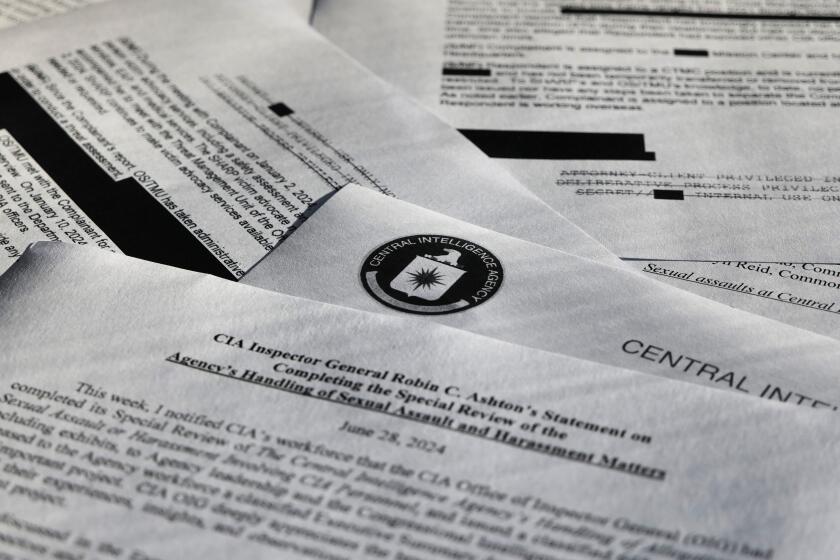Information Superhighway Carried Raines to His Exit
Just as the embedded reporters’ live dispatches from the battlefields of Iraq changed popular expectations concerning war correspondence, so has the Internet altered how a story such as the current New York Times scandal can unfold.
Much was unprecedented about the events that on Thursday forced Times Publisher Arthur O. Sulzberger Jr. to accept the resignations of Executive Editor Howell Raines and Managing Editor Gerald Boyd and to summon Joseph Lelyveld, 66, out of retirement to assume the paper’s interim leadership. Raines is the first editor to leave in disgrace since the Ochs/Sulzberger family purchased the Times more than a century ago. In fact, historians of the paper believe no similar resignation has occurred in its 152-year history. Nor has a former executive editor ever been brought out of retirement as has Lelyveld, Raines’ immediate predecessor.
More significant, the Times scandal -- which began a little more than a month ago when it was revealed that 27-year-old reporter Jayson Blair had fabricated and plagiarized news stories -- was the first institutional crisis of its kind to unwind in real time. Just as live combat reports from the Iraq war transfixed a global audience, so too did reports on events inside the New York Times transmitted via Internet media news sites, online magazines and newspaper editions, blogs and e-mails.
Every significant turn in the entire sequence and every memo issued by Sulzberger, Raines and Boyd was immediately posted on the Internet. When Rick Bragg, the paper’s Pulitzer Prize-winning feature writer and a Raines favorite, was suspended for turning in a story based on an unsalaried freelance writer’s uncredited work, he defended his conduct as standard among the Times’ national correspondents. For 24 hours or so, that defense caromed around the Internet, uncontradicted by Raines or Boyd.
Then, one after another, Times reporters began sending their own blistering rebuttals to the popular news media Web site maintained for the Poynter Institute by Jim Romenesko. Within hours, what amounted to a rhetorical free-for-all among Times reporters was on display for the whole wired world. Raines and Boyd were forced to issue a memo defending their national staff’s practices, but it was too little, too obtuse and too late.
At one point, the Washington Post published an account of an ongoing spat between Times reporters John Burns and Judith Miller -- another Raines favorite. The story was based on an internal e-mail exchange between the two that obviously had been leaked by someone inside the Times. Among the most embarrassing bits of information contained in the electronic correspondence was Miller’s admission that her primary unnamed source for a series of reports alleging Saddam Hussein’s possession of weapons of mass destruction was an Iraqi exile leader with a vested interest in seeing the United States overthrow the Baathist regime.
And so it went, with each day’s instantly available disclosures triggering a fresh round of real-time commentaries, which in turn nudged those in possession of additional embarrassing information into virtually instantaneous rounds of fresh revelation.
It was death by a thousand comments, and a spectacle that produced something the Times and its owners found as novel as the situation -- ridicule. The Sulzbergers are among American journalism’s great stewards and the newspaper they have nurtured conceives of itself as an institution of rectitude. They are not people accustomed to finding their newspaper the butt of late-night talk show hosts’ comic monologues and “Top Ten” lists. But they were, day after day.
Pressure began to build last week, according to sources at the Times, when senior members of his family began telling Sulzberger that the time had come for the two editors to go. As recently as Tuesday, however, Sulzberger told a luncheon meeting of the paper’s Washington bureau that he had no plans to seek the executive editor’s resignation.
In separate conversations that day, Raines told at least two senior members of his staff that he and Boyd had been holding “long talks” about how to get the paper moving again once the scandal was behind them. Wednesday, however, all that changed. Raines began to hint to friends that his exit was imminent and, that night, Sulzberger dined with Lelyveld to finalize arrangements for his return as interim executive editor.
Thursday, as Sulzberger announced his acceptance of Raines’ and Boyd’s resignations and Lelyveld’s return, Times staff members with a sense of history noted that Arthur Sulzberger Sr. -- the paper’s beloved former publisher and chairman emeritus of the New York Times Co. -- stood in the newsroom, a silent witness. Now, some of those staff members are wondering whether the brash young publisher, who less than two years ago pushed Lelyveld into an earlier-than-expected retirement to make way for Raines, will himself emerge from this affair simply chastened or badly wounded.
In either case, the new media’s vast echo chamber already has demonstrated something that cannot be ignored: Questions about the Times’ revival now will be posed and answered at speeds and in ways that defy the sober standards of conventional crisis management.
Thursday, just moments after Raines donned one of his signature straw hats and walked off into the light rain falling outside the paper’s 43rd Street offices, Times reporter Jacques Steinberg’s account of the morning’s events appeared in the paper’s online edition. One paragraph in his admirably balanced and thorough report could stand as the Times’ official summary of the whole affair: “After the deceptions of Mr. Blair were brought to light, in a four-page article that was published on Mother’s Day, it became clear that Mr. Raines’ hard-charging leadership style had not only played a role in creating the atmosphere that allowed Mr. Blair to do what he did largely undetected, but had also alienated him from his staff.”
A little less than two years ago, when Howell Raines began what he and his publisher believed would be a period rich in promise, the new executive editor vowed to raise the Times’ “metabolism.” That he did, though mostly for the worse.
And, in the end, it was the new world of Web sites, blogs, online editions and e-mails -- not Raines -- that set the pace of his exit.
More to Read
Sign up for Essential California
The most important California stories and recommendations in your inbox every morning.
You may occasionally receive promotional content from the Los Angeles Times.










